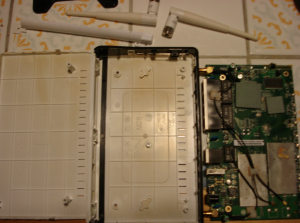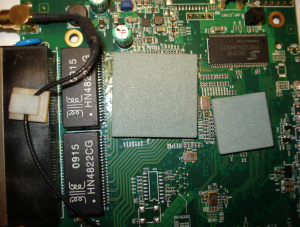We’ve had a DLink DIR825 wireless router for about a year. It’s biggest pro is that it’ll run 2 separate wireless networks at the same time, so you can have for example… a 5Ghz N-band running as well as a separate 2.4GHz G/B band.
When we bought it, it cost well over $100, so the thinking was “you get what you pay for, so it’ll probably be good”.
Well…. it’s not.
It took less than a year, and the thing started having issues during the summer. More specifically, if it had been running and it lost power (you unplugged it for instance), it wouldn’t start up when you plugged it back in. The “D-Link” light would come on, and nothing else. It was getting power, but refused to start.
Leaving it unplugged for a lengthy time (30 minutes or so) allowed it to cool down enough that it would start up again.
It’s largely been sitting since (been replaced with an Apple Time Capsule for a while), but today I decided to open it up and have a look. I really expected (and hoped for) a bulging capacitor or something that could be easily fixed with a bit of soldering and a donor cap, but no such luck.
Here’s what it looks like disassembled:

The DIR 825 opened up (click image to view a larger picture). Note the discoloration on the upper areas of the white plastic casing.
You’ll notice the discoloration on the inner plastic. It’s not dust. Plastic turns yellow as it starts to melt. The yellowing is located near the position of the 2 heatsinked chips. If this wasn’t a sign of overheating, I don’t know what is.
For a closer look at the “heatsinks”, look here:

The oddest “heatsink material” I’ve ever seen in my life. Click the image for a slightly larger version.
The material feels like some sort of fine granite.
I plugged the circuit board into power, and waited. It didn’t take long for the “heatsinks” to start heating up.
With the abundance of aluminum, copper, and many other cheap metals, it’s appalling that this was used as a heatsink. Then again, if they used material that would actually transfer heat away from the chips quickly I supposed it would have started melting the entire casing.
In any case, it’s no wonder this thing died an early death.
—
So what should you take from this…? Well, the thing isn’t exactly built to rugged standards. If you’ve got this router I suggest locating it right beside an air conditioning duct.
Really, D-Link should have designed the enclosure differently (to reduce the chance of the thing starting to melt and to promote airflow), used a lower power chip, and used a “real” heatsink. Alternately, they could have simply added a small fan to force some airflow.
—
Short version: Don’t buy. This thing belongs in the same price bracket as the budget-routers out there. If you want a budget router to last you a year and can find the DIR-825 for under $30, go for it. Otherwise, look elsewhere.
–
I was thinking about a heatsink upgrade, but I have not opened up the cases of my routers yet since they are still under warranty. From what you saw does it look like you can remove the "heatsink material" or is it stuck on the chip?
It's stuck on the chip - not sure if it's double-sided tape or if it's glue. If I were to *try* removing it I suppose I'd try twisting/rotating the heatsink - there's ample room to get a grip on it - it's just a matter of whether it comes off happily or decides to take a portion of the chip/die with it.
That said, since you're under warranty it's a bit of a toss-up. If the thing dies while under warranty, you get a new one. If it dies just after the warranty ends you might wish you'd replaced it.
Alternately, a weather proof box might be a little tough to mod (assuming you want to keep it weatherproof anyway), but it might be possible to use a little creativity to improvise some sort of a routed vent out the top (and perhaps some intake slits at the bottom for cool air). Anything that lends itself to obtaining some airflow can only be helpful.
In my case, something happened sometime in the last few months to cause my network to bottleneck. I was only getting 1/15th of the internet upload speed I was supposed to be getting. After replacing the router, it went to normal. After finding that one of the antennas was flopping around, I decided to take it apart, figuring there was a nut on the inside that had come off. Turns out that the antenna connector was broken clean off of the circuit board. Seems that you are right about not being very rugged. However, it looks like they did solve the heating problem - or at the very least, the plastic discoloration. Looking at your pictures, there is a big M28 stamped on the inside of the case. Mine has M29, and there is no discoloration at all, and this router was powered up continuously for the last three or four years.